
Booze, Sailors & Health Menu: 1 2 3 4 5 6 7 8 9 10 11 12 13 14 15 16 17 18 19 Next>>
Booze, Sailors, Pirates and Health In the Golden Age of Piracy, Page 11
Alcohol - Punch
"You may talk of brisk Claret, sing Praises of Sherry,
Speak well of old Hock, Mum, Cider and Perry;
But you must drink Punch if you mean to be Merry."
(Original Author Unknown, A Pedlar's Pack of Ballads and Songs, 1869, William Hugh Logan & James Maidment, editors, p. 233)
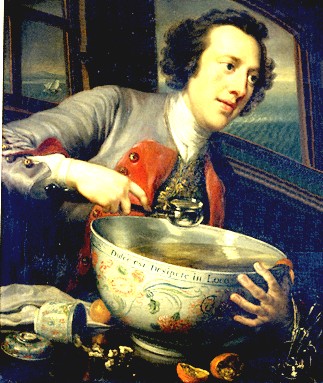
Artist: George Knapton
Sir Bourchier Wray Serving Punch on a Navy Ship (1744)
Punch is not actually a pure-bred alcoholic beverage, it is a mixed drink. In fact, it is probably one of the first internationally famous mixed drinks in history. Note the 'probably' in that sentence. Like many mixed drinks, a cloud of vagueness seems to surround the details of punch.
Take its origins. It first appears to have its roots in India, yet it may not necessarily be a creation of the Indians. David Wondrich (who quite literally wrote the book on punch) notes that the "problem for the claim that Punch is an Indian creation is the dearth of actual seventeenth-century evidence of the native peoples of the region drinking the stuff. It's not mentioned in their own writings, or at least no such mention has yet filtered through to the West."1
When discussing the drink in his 1657 travelogue, French aristocrat François de La Boullaye-Le Gouz defined punch: "Bolleponge est un mot Anglois, qui signifie une boisson dont les Anglois usent aux Indes"2. This translates to: 'Bolleponge is an English word, which means a drink which the English use in India'. The Indians are not mentioned here. In fact, no one is mentioned here but the English. Writing in the 1660s, fellow Frenchman and physician François Bernier referred to a drink he called Bouleponge which he encountered at the English and Dutch East India Company factories in Bengal, India during his visit there.3
However, punch's origins reach even further back. Robert Addams, a man-at-arms for the East India Company, wrote a letter from his post in Southern India to factor Thomas Colley on the
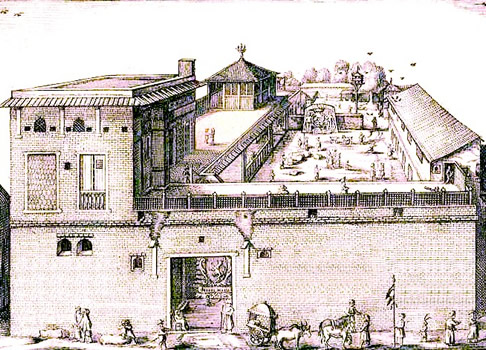
EIC Factory at Surat, From Voyages Celebres et Remarquables, By Johan Albert Mandelslo (1727)
Bay of Bengal on September 28, 1632 which included the warning: "I hop you will keep good house together and drincke punch by no allowanc."4 Here again, the English are found consuming punch. Writing six years later about his trip to the English East India Company's factory in Surat, India, German adventurer Johan Albert de Mandelslo explained that "every man was at liberty to drink what he pleas'd, and to mix the Sack as he thought fit, or to drink Palepuntz, which is a kind of drink"5. English agriculturist John Worlidge must have read de Mandelso's book, for in 1678 he explains in his book Vinetum Britannicum, "Pale-puntz, here [England] [is] vulgarly known by the name of Punch"6. The recurring element in these examples, written by natives of three different countries, is England. In the three earliest references, the reference is even more specific: the English East India Company. This does not provide the origin of the drink (which must remain unknown unless a better or earlier reference turns up), but it suggests the company for which the responsible party likely worked.
A little less vague, but still unclear, is the origin of the name of the beverage. Note how the
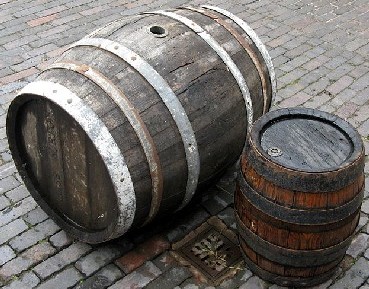
Photo: Dave Pickersgill - Casks, Possibly Puncheon-Sized
above examples bring the name full-circle: from punch (1632) to Palepuntz (1638) to Bolleponge (1657) to Bouleponge (1660s) and back to punch (1678). Writing on the origins of the term 'punch' in 1905, Oxford English Dictionary lexicographer Charles Bridges Mount points out that "palepunzen, ...[is] understood... to represent the English "bowl-of-punch," as does a corresponding French word bolleponge"7. He suggests that the word might have originated with English sailors, have been "adapted from the puncheon, to which all sailors would look for their allotment of rum"8. Unfortunately for this very appealing explanation, the known origins of term punch pre-date the regular provision of rum to the navy-men in a puncheon cask and the rum tot by decades.
Navy physician John Fryer offered a very different origin for the word in 1698, explaining that "the English on this Coast [of Goa, India] make that enervating Liquor called Paunch ['Panch'] ( which is Indostan for Five) from Five Ingredients"9. However, he is the only source for this explanation, writing close to seventy years after the term was first mentioned. Add the lack of support from Indian literature which Wondrich mentioned and this explanation seems rather unlikely.
No less vague are the ingredients of punch themselves. Punch consisted of five ingredients (except when it didn't). La Boullaye-Le Gouz listed "sucre, suc de limon, eaue de vie, fleur de muscade & biscuit rosty."10
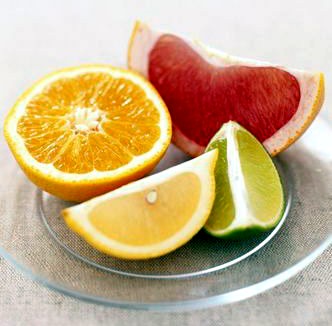
A Variety of Citrus, An Important Ingredient in the Recipe
(You PROBABLY can ignore the grapefruit.)
This translates to 'sugar, juice of lime, water of life (probably arrack or brandy), nutmeg & roasted (or toasted) biscuit.' (Note that limon during this period often referred to limes.) Johan Albert de Mandelslo said the ingredients were "Aqua Vitae [probably either brandy or arrack], Rose-water, juice of Citrons and Sugar."11 Bernier recorded it as "a drink composed of arac, a spirit distilled from molasses [likely referring here to distilled cane wine, not rum, based on his location], mixed with lemon juice, water and nutmeg"12. Worlidge says the drink is "compounded of Brandy or Aqua Vitae [probably arrack, although it might be something else given that he was in England where multiple alcohols were in use], juice of Lemons, Oranges, Sugar, or such-like"13. Thomas Tryon, though no fan of the drink, listed the ingredients in 1684: "Brandy or Rum, Sugar, Water, Lime-Juice, and sometimes Ginger or Nutmegs"14. Recipe number 252 in Hannah Woolley's 1670 cookbook recommends "To make Punch. Take one Quart of Claret wine, half a Pint of Brandy, and a little Nutmeg grated, a little Sugar, and the Juice of a Limon, and so drink it."15
Several physicians weigh in with punch recipes. As noted previously, naval physician Fryer
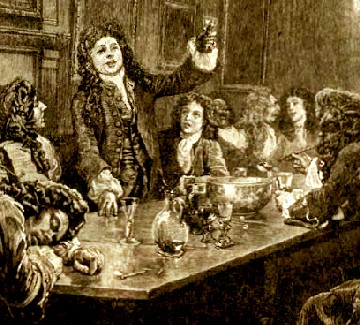
Artist: Charles Green - Drinking Punch, From The Graphic (1884)
mentioned in 1698 that punch contained five ingredients, although the only one he lists is arrack.16 Fellow physician William Hughes said in 1670 that punch "is made of Spirit of Wine [brandy] (or else with Rum) Water and Sugar, with... the juyce of Limes"17 Physician William Salmon gave a recipe in 1693 which included quantities. A 1694 edition citation advises: "If you would make a pleasant and grateful sort of Punch, you must compose it with the following quantities. Rx. Fair Water [spring water], choice Brandy {of each} a Quart; pure Lime-juice a Pint: double refined Sugar {1 pound} mix and dissolve, and if you so please, add one Nutmeg grated."18 In 1707, physician Hans Sloane, less than enthusiastic about the drink, explained that "into the composition of [punch] goes Rum, Water, Lime-juice, Sugar, and a little Nutmeg scrap'd on the top of it."19
Now, if you've been keeping notes, you will have accumulated quite a list of possible ingredients from these recipes. The basic ingredients of punch are an alcohol (occasionally two), citrus juice, water, sugar and spices. Toasted biscuit appears in one recipe, but it does not appear in the
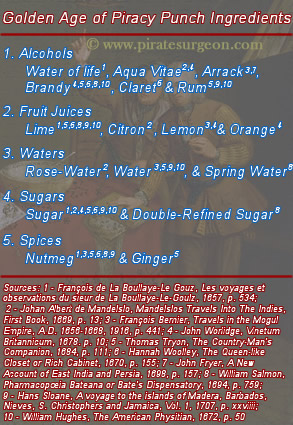
Golden Age of Piracy Punch Ingredients
other nine, so it will be ignored here. (For the record, Wondrich says that this refers to the twice baked biscuits or hard tack that sailors had available to them, which once again calls to the sea connection.20) However, since the possible combinations of the other ingredients are a bit dizzying, they have been sorted and placed in the chart seen at right with notes as to who advised what for handy reference.
A couple of explanatory notes are in order here. First, water of life and aqua vitae are basically the same thing - a reference to a generic distilled beverage. (Aqua vitae is actually Latin for 'water of life'.) Their likely analogs were noted in the preceding text. Second, not every author included all five of these basic ingredients in their recipes. Finally, some authors listed more than one possible ingredient for the same ingredient category explaining why some of the references appear twice in a single ingredient category.
The ingredients selected by each author likely had more to do with what was available to them than any other factor. This explains why arrack appears as the spirit of choice in several recipes written by East India-based writers - arrack was cheap and easy to get there. However, outside of the East Indies, it was a different story. Wondrich explains, "people had learned to replace the exotic, expensive and often hard-to-get arrack with brandy in England and rum in the Americas - the former because it was the best thing they could get, the latter because it was the only."21 Writing of his experience in Jamaica, John Oldmixon explained in 1708 that "French Wine and Brandy are dear, and Lemons scarce, [so] Rum-Punch has been much us'd, and Lime juice supply'd the place of Lemons."22
The flavor of punch had much to do with its spread. Satirist Edward Ward said in his poem In Praise of Punch, "Thou hast an Excellence surpassing Wine, And art the only Cordial thats Divine."23. Wondrich reports that Ward also said "if [punch is] composed of good ingredients, and prepared with true judgment, [it] exceeds all the simple [i.e., straight, unmixed], potable products in the universe"24. Physician William Hughes opined that the key element was "as much of the
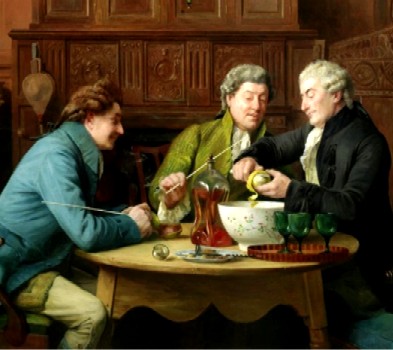
Artist: Walter Dendy Sadler - Making Punch, "A Good Bowl of Punch" (1886)
juyce of Limes as will give it a fine picquancie or sharpness."25 The water helped dilute the alcoholic proof spirits and the sugar would have balanced the tang of the citrus fruits. It may seem that when oranges were used, they would have provided a sweeter flavor and more balance, but Wondrich suggests that a period punch recipe would have likely used Seville oranges which are usually described as being bitter or sour.26
Of course, the flavor of any punch would have had much to do with which ingredients were used and the proportions with which they were mixed. Brandy would have provided a smoother note than rum or arrack, both of which would have had funky, vegetative flavors at this time. The citrus employed (if Wondrich is correct) would usually have been sour. (Wondrich elsewhere notes, "Made with the common sweet orange, Orange Punch, for all its pleasantness, lacks that dynamic tension that the best Punches maintain."27) The amount of sugar needed for this punch is not mentioned in eight of the ten period recipes cited above. The two authors who do indicate the quantity of sugar in their recipes stand at opposite ends of the spectrum. Hannah Woolley only recommends "a little sugar"28, while William Salmon suggests adding a pound of sugar to two quarts and a pint of other liquids. Wondrich claims that an eighteenth century punch seller found the perfect ratio of ingredients: "one part spirits to two parts water, citrus and sugar. Assuming said spirits were roughly half alcohol [proof spirits], that yields a Punch that's about 16 percent alcohol (by volume) - the strength of a (very) strong California Cab or a light sherry."29 Given the English preference for sweet wines at this time, it would seem that a healthy dose of sugar would have been used.
Punch could also be drank hot or cold. In the account of Francis Sprigg's pirate crew, prisoner Richard Hawkins noted that the sailor stationed in the mast-head (what we would today call the crow's nest) was ordered to "let down a Rope to hawl up some hot Punch, which is a Liquor every Man drinks early in the Morning. They live very merrily all Day"30. Indeed. However, the temperature is not generally specified and punch was presumably to be served at room temperature unless otherwise specified. (Of course, ice would not be found on a ship in warm waters at this time.)
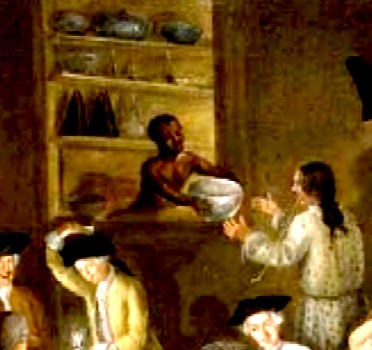
Artist: John Greenwood
Buying Punch, From Sea Captains Carousing in Surinam (1752-8)
Wondrich also points out that punch was expensive in England. He says that a bowl of punch there which would have been made from arrack, French brandy or rum imported from the New World would have cost "six or eight shillings a three-quart bowl."31 (Keep in mind that punch was served in large bowls and meant to be shared.) Of course, sailors were closer to the source for the elements needed to make punch and would not have had to pay so much. When privateer Woodes Rogers reached Batavia (modern Jakarta, Indonesia), he said that his crew
were hugging each other, others blessing themselves that they were come to such a glorious Place for Punch, where they could have Arack for 8 Pence per Gallon, and Sugar for 1 Peny a Pound; others quarrelling who should make the next Bowl, for now the Labour was worth more than the Liquor, whereas a few Weeks past, a Bowl of Punch to them was worth half the Voyage.32
In addition to highlighting price, this quote shows both how important the location was to the ingredients used in the punch as well as how much sailors thought of it.
Location also impacted the price of the other ingredients required for punch. A Captain Jacobs brought a variety of alcohols to the Madagascar-based pirates in 1698 which included rum, wine, beer, lime juice and sugar.33 Editor Ed Fox points out that "until the very end, when rum reached the price of 5 pieces of eight per gallon [probably because Jacobs was running out of it], lime juice was the most expensive drink"34, indicating just how important the ability to make punch was. In a similar vein, an employee of the East India Company at Calicut, India was stopped by a man from a ship anchored off-shore in 1691 and handed a letter. The letter indicated that they were pirates because of the 'troublesome times' and that they wanted "to clean our ship at your haven, and get some wood and water, as well as provisions for refreshing our men, for which we honestly design to pay"35. No reply was received, so another letter was sent warning that they if they couldn't pay for the goods, they would come and take them. In case claification was needed on the reason for requesting lime, this letter added, "Send us a hogshead of rum and sugar equivalent for punch"36. Apparently they had used all of theirs up while awaiting a reply.
1 David Wondrich, Punch, 2010, p. 30; 2 François de La Boullaye-Le Gouz, Les voyages et observations du sieur de La Boullaye-Le-Goulz, 1657, p. 534; 3 François Bernier, Travels in the Mogul Empire, A.D. 1656-1668, Translated by Archibald Constable and revised by Vincent A. Smith, 1916, p. 441; 4 Wondrich, p. 22; 5 Johan Albert de Mandelslo, Mandelslos Travels Into The Indies, First Book, 1669, p. 13; 6 John Worlidge, Vinetum Britannicum, 1678. p. 10; 7 Charles Bridges Mount, "Punch, the Beverage", Notes and Queries, Tenth Series - Volume IV, July - December, 1905, p. 401; 8 Mount, p. 402; 9 John Fryer, A New Account of East India and Persia, 1698, p. 157; 10 de La Boullaye-Le Gouz, p. 534; 11 Mandelslo, p. 13; 12 Bernier, p. 441; 13 Worlidge, p. 10; 14 Thomas Tryon, The Country-Man’s Companion, 1684, p. 111; 15 Hannah Woolley, The Queen-like Closet or Rich Cabinet, 1670, p. 155; 16 Fryer, p. 157; 17 William Hughes, The American Physitian, 1672, p. 50; 18 William Salmon, Pharmacopœia Bateana or Bate’s Dispensatory, 1694, p. 759; 19 Hans Sloane, A voyage to the islands of Madera, Barbados, Nieves, S. Christophers and Jamaica, Vol. 1, 1707, p. xxviiii; 20 Wondrich, p. 37; 21 Wondrich, p. 125; 22 John Oldmixon, The British Empire in America, 1708, p. 155; 23 Ned Ward, "In Praise of Punch" The London Spy Compleat, 1703, p. 338, gathered 12/14/17; 24 Wondrich, p. 51; 25 Hughes, p. 50; 26 Wondrich, p. 79; 27 Wondrich, p. 170; 28 Woolley, p. 155; 29 Wondrich, p. 65; 30 Captain Richard Hawkins, The British Journal, 8/22/1724; 31 Wondrich, p. 54; 32 Woodes Rogers, A Cruising Voyage Round the World, 1712, p. 390; 33,34 Ed Fox, “67. Prices of Pirate Supplies: A List of the Prices that Capt. Jacobs sold Licquors and other Goods att, at St. Mary’s, 9 June, 1698…”, Pirates in Their Own Words, 2014, p. 362; 35 Charles Grey, Pirates of the Eastern Seas (1618-1723), 1933, p. 123 - This quote also mentioned 'chunam', which Grey says refers to lime, which I thought might also mean the punch ingredient lime fruit. However, Pat Collins, a reader, noted that 'chunam' refers to mineral slaked lime, which is used in chewing betel nut; 36 Grey, p. 124
Punch and Sailors
Based on the period evidence, sailors really liked punch. John Worlidge pointed out that punch drinking was "very usual amongst those that frequent the Sea, where a Bowl of Punch is an usual Beverage."1 Use among sailors definitely goes back before that, though. It was already enough of a problem amongst them that Frenchman François Bernier noted that at the English and Dutch Companies in Bengal, "The masters of vessels take care that their crews drink less punch"2. The sailors affinity for punch should not be surprising given its
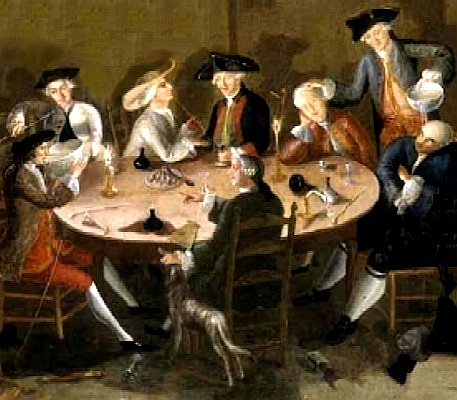
Artist: John Greenwood - From Sea Captains Carousing in Surinam (1752-8)
connection to the East India Company, owner of a large number of ships. Charles Bridges Mount actually proposes "that punch was originally a drink of sailors"3 indicating they may be responsible for its creation. As Mount explains, "Sailors of different nationalities, when not fighting each other, are apt to be good comrades, and the Dutchmen and the Frenchmen may quite possibly have
learnt to drink punch in seaports far from India."4
There is something in this. Henry Jeffreys explains that "Punch houses opened throughout British India. In 1707 in Calcutta alone there were seven hundred."5 While there was an East India factory in Calcutta (then called Calicut by the English) on the Malabar Coast of India, their employees probably couldn't support seven hundred places serving punch. Writing of a visit to St. Helena in the South Atlantic off Africa in 1691, buccaneer William Dampier notes that "the Punch-houses were never empty."6
Whether sailors were the original creators of punch or not (and it can't be completely ruled out), they were certainly responsible for its spread and eventual popularity. It was through the sailors that punch got to England. One of the first references to the drink in the homeland comes from John Evelyn's visit to an East India ship in 1662 at Blackwall on the Thames. He says, "We had entertainment of several curiosities... [including] spiritous drinks, [such] as punch"7. Its use among sailors also explains how punch made it from its origin point in the East Indies all the way over to the West Indies. Drink historian David Wondrich explains that
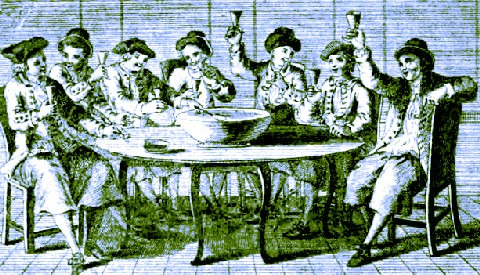
The British Sailor's Loyal Toast,
Taken from The British Tar in Fact and Fiction, p.136 (1738)
"English sailors were customarily dismissed from their ships between voyages and had to find new ones, many of those who manned the vessels that serviced the new western colonies would have had East India Company experience."8
Punch is directly mentioned seventy-two times in the period accounts, three times in use by navy sailor9, seventeen times in use by naval officers10, fifteen times in use amongst the merchants and privateers11 and thirty-five times amongst the pirates.12 As noted in the section of rum, there are a variety of citations which mention sailors have punch ingredients without specifically stating they were used to make punch. These are not included in the above numbers. They include one merchant privateer citation13 and eighteen pirate citations14, with sixteen of the pirate citations referring to rum and sugar, one referring to rum and lime juice and one referring to arrack and sugar.
This data also excludes two drinks that were basically punch, but which were called by other names. The first is William Kidd's 'Bomboo'. During the trial, Josiah Palmer testified that bomboo "is made of Water, and Limes, and Sugar"15. Although he fails to include it in his testimony, it also contains an alcohol, most likely arrack since Kidd was in the East Indies. (Do those ingredients sound familiar?)
The second excluded drink is a little bit more of a stretch: sangaree, the drink that preceded sangria. Aboard the merchant vessel Spy Galley, Francis Rogers explained that, after a French privateer veered off from attacking them in June of 1704, "Captain Kimber and I went down into our cabin and made us a large bowl of Sangaree to rejoice over our good fortune,
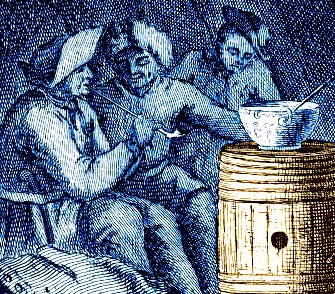
Artist: Joseph Nicholls
George Lowther's Pirates Drinking Punch (1736)
but before our bowl was out, about 1 hour and a ½ or 2 hours after, [in] comes the Mate or one of our people, and tells us there were 3 ships in sight"16. Rogers doesn't give the ingredients of his 'Sangaree', although he later refers to it as 'wine'. To get any idea of what it might be requires going beyond the golden age of piracy. In 1736, The Gentleman's Magazine stated that a punch seller in London had "devised a new Punch made of strong Madeira Wine, and called Sangre"17, suggesting that the drink was even then viewed as being a type of punch. This is confirmed in Francis Grosse's Dictionary of the Vulgar Tongue which, in 1785, defines sangaree as "rack punch"18. Modern definitions mention sangaree as being "sweetened... [and] garnished with nutmeg"19 and "sweetened red wine and orange or lemon juice with soda water"20. These ingredients should sound quite familiar by now. Even the Oxford Companion to American Food and Drinking states that "Sangaree ...was a punch made of sweetened [with sugar], diluted [with water] red wine [which was] spiced with nutmeg."21
Adding the number of indisputable punch citations to the punch ingredient citations and the two punch variant citations results in punch being found in three naval citations, nine merchant and privateer citations and an astonishing forty pirate citations. Clearly punch had an important place at sea.
Punch was primarily drunk by the officers in the Navy based on the limited accounts under consideration. But when they drank it, how they drank it! Naval chaplain Henry Teonge twice commented that punch was as plentiful in the officer's mess as 'ditchwater', once during the early days of his service aboard the HMS Assistance in June of 167522 and the second time when entering service on the HMS Bristol in May of 1678.23 Eighteen of the nineteen naval references to punch come from his book. Although he suggests that punch was prevelant on each ship, it is in his diary of the voyage of the assistance where the majority of the references to punch come from. Upon first encountering it, Teonge says he "dranke part of 3 boules of punch, (a liquor very strainge to me;) and so to bed in a cabin so much out of order"24. He quickly acclimated, mentioning many toasts being drunk to the monarch, friends, wives and others in 'good boules' of punch in his book. By mid-July, it was such a regular feature of dinner that he commented, "(according to our woonted custum) wee end the day with two boules of punch."25
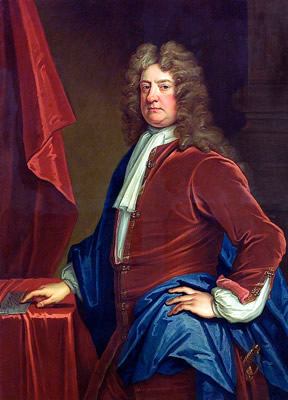
Artist: Thomas Gibson - Admiral Edward Russell (1715)
The most impressive example of period navy officers sharing an ever-flowing bowl of punch comes from a party thrown by Admiral Edward Russell when he was stranded by the Navy in Cadiz, Spain over Christmas in 1694. Russell took the concept of a bowl of punch to a whole new level. Holding his party in the garden of the governor of Cadiz's house, Russell invited all the English and Dutch officers of the fleet. David Wondrich (quoting period sources) explains, "at the center of the garden [was a] large, Delft-tiled fountain with the canopy rigged over it, filled with ‘12 hoggsheads of punch.’ And, of course, the ‘little boy that was in a boat swimming on the punch sea and deliver(ing) it to the Company."26 If the description was accurate, a hogshead being 121 imperial gallons, meant that the fountain contained 1452 imperial gallons of punch! Francis Moore reported in 1711, "In this fountain, on Christmas-day, was poured six butts of water, half a hogshead of strong mountain Malaga wine, two hundred gallons of brandy, six hundredweight of sugar, twelve thousand lemons, and nutmegs and sugar in proportion."27
Punch eventually made its way to the naval ranks as well. Edward Vernon's order to water down the rum in 1740 says, that the sailors' "half pint of rum [is] to be daily mixed with a quart of water, which they that are good husbands may from the savings of their salt provisions and bread purchase sugar and limes to make more palatable to them"28. All the judicious navy foremastman needed to complete the recipe was a bit of nutmeg.
Since that the East India Company was instrumental in introducing punch to the world, it should not be surprising that it was prevalent among some of the merchant crews. While future pirate Henry Every was plotting mutiny aboard the Charles II, Charles Johnson explained that the merchant ship's "Captain was one of those who are mightily addicted to Punch, so that he passed most of his Time on Shore, in some little drinking Ordinary"29. On the night of the mutiny, the captain had imbibed his normal dose and
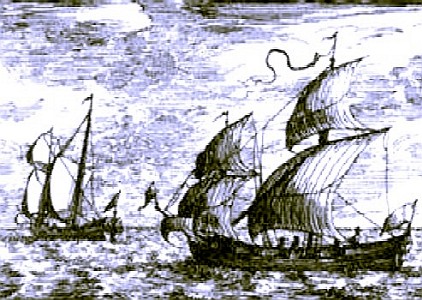
Barque Longues, From Bâtiments Mer Méditerranée Et De L'océan,
By Géroult du Pas (1710)
was neatly in bed an hour before Every's mutiny was planned to start.
While purchasing slaves at 'New Callabar' (Kalabari Kingdom), Silas Told explained that local resident (and possibly one of the sellers of slaves, although this is not entirely clear from the text) came on board the slave ship Scipio where the Captain, "having made a tub of punch on the quarter-deck, had the fidler and the ship's company dancing with him, but left me with Tom Ancora to purchase the slaves."30 Punch was a part of doing business.
Of course, as the number of occurrences attests, it was the pirate who excelled at drinking punch. Future pirate captain James Kelley was recruited by Captain 'Trustan' [Tristan?] on the crew of his barca longa which was part of the fleet of buccaneer Jan Willems ['Captain Yankee']. Willems sent the barca longa and a prize ship to Petit-Goâve (modern Haiti), presumably to get supplies. They were blown off course to nearby Nippes, where Trustan went ashore, sending back "a Bumboat with Brandy, Lime- Juice and Sugar... [of which] the Frenchmen made a Bowl of Punch by the Main Hatch, and we by the Binacle"31. This appears to have been at least part of the impetus for Kelley and co-conspirator Randal Hicks to take control of the barca longa. It is notable that they were making a brandy-based punch here, possibly reflecting the French ownership of the island.
In the Caribbean, rum was the usual alcohol put into the punch. When Nathaniel Uring was among the logwood cutters in Central America, many of whom were former buccaneers and pirates, he commented, "Rum Punch is their general Drink, which they’ll sometimes sit several Days at also; they do most Work when they have no strong Drink, for while the Liquor is moving they don’t care to leave it."32 In preparation for holding a trial of men suspected of trying to escape from Bartholomew Robert's crew, "a large Bowl of Rum Punch was made, and placed upon the Table, the Pipes and Tobacco being ready, [then] the judicial Proceedings began"33.
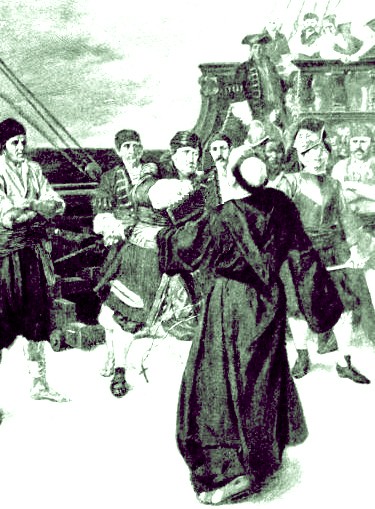
Artist: J. N. Marchand
The Religious Held a Tenuous Position When Aboard a Pirate Ship,
From Sir Henry Morgan Buccaneer, By Cyrus Townsend Brady, (1903)
Punch inspired the pirates to all sorts of foolishness. As Wondrich points out, "Punch, even at its most carefully compounded and wholesome, remained something of a spree drink, fuel for a devil-take-the-hindmost journey to the end of the night"34 which perfectly suited the demeanor of many pirates. A chaplain heading for Cape Coast Castle ( a commercially run fort on the west coast of Africa) was unintentionally swept up by Bartholomew Roberts crew when they captured the merchant vessel Onslow.
[S]ome of the pirates were for keeping him, alledging merrily, that their Ship wanted a Chaplain; accordingly they offered him a Share, to take on with them, promising, he should do nothing for his Money, but make Punch, and say Prayers; yet, however brutish they might be in other things, they bore so great a Respect to his Order, that they resolved not to force him against his Inclinations"35.
This was fortunate for the pastor, who politely declined. (Although this was clearly done in jest, it does suggest the complexity of making proper punch, which is not discussed in detail in this article. For more on this, see David Wondrich's book Punch.)
Punch stirred the worst emotions in men and several examples show pirates to be particularly subject to its influence. One of Roberts men, William Davis, "consorted to the idle Customs and Ways of living among the Negroes, from whom he received a Wife, and ungratefully sold her, one Evening, for some Punch to quench his Thirst."36
Merchant George Roberts of the Margaret who was captured by Ned Low's pirates explained how

Artist: Howard Pyle - Then the Real Fight Began (pre-1911)
a "great silver bowl was brought full of punch" was brought out one evening which nearly resulted in his death at the hands of John Russell née Lopez, captain of a schooner in Low's fleet. Russell was predisoposed against Roberts because he managed to avoid being made navigator of the crew. Although he was not married, he claimed to be, which went against one of Low's crews articles. After a round of drinking healths, where Russell set Roberts up, he exploded in anger at the man over a trifling issue, "damning me, and calling me Rascally Son of a B-"37. Roberts attempted to calm Russell, which failed. Russel whipped the "Pistol from his Sash, and cock'd it, and swore he would shoot me through the Head, and was sure he should do God and his Country good Service, by ridding the World of such a traiterous Villain. But the Master of the Scooner prevented him, by striking the Pistol out of his Hand."38 This was not the end of Russell's emnity; he continued to harass and threaten Roberts for the rest of the time among Low's pirates, finally managing to prevent Roberts from being allowed almost anything of value or use when they let him go.
There are a several other interesting punch-related tales in the pirate literature, but we'll save those for later sections of this article.
1 John Worlidge, Vinetum Britannicum, 1678. p. 10; 2 François Bernier, Travels in the Mogul Empire, A.D. 1656-1668, Translated by Archibald Constable and revised by Vincent A. Smith, 1916, p. 441; 3 Henry Jeffreys, Empire of Booze, 2016, p. 126; 4,5 Charles Bridges Mount, "Punch, the Beverage", Notes and Queries, Tenth Series - Volume IV, July - December, 1905, p. 402; 6 William Dampier, Memoirs of a Buccaneer, Dampier’s New Voyage Round the World -1697-, 1968, p. 365; 7 John Evelyn, The Diary of John Evelyn, vol. 1, 1901, p. 356; 8 David Wondrich, Punch, 2010, p. 44; 9 Henry Teonge, The Diary of Henry Teonge, Chaplain on Board H.M.’s Ships Assistance, Bristol, and Royal Oak, 1675-1679, 1825, p. 25, 28-9 & 235; 10 Henry Teonge, The Diary of Henry Teonge, Chaplain on Board H.M.’s Ships Assistance, Bristol, and Royal Oak, 1675-1679, 1825, p. 4, 12, 21, 26, 28, 36, 99, 159, 198, 236, 238, 261, 270, 271, 303 & 304 & David Woodrich, Punch, 2014, p. 153; 11 Francis Rogers. from Bruce S. Ingram's book Three Sea Journals of Stuart Times, 1936, p. 180 & 182, Woodes Rogers, A Cruising Voyage Round the World, 1712, p. 106, 359 & 390, Silas Told, An Account of the Life, and Dealings of God with Silas Told &c., 1786, p. 26; 12 Daniel Defoe (Captain Charles Johnson), A General History of the Pyrates, Manuel Schonhorn, ed., 1999, p. 127, 150, 167, 172, 222, 228, 270, 279, 334, 436, 478, 508, 525, 588, 591, 608, 609 & 650, Clement Downing, A Compendious History of the Indian Wars, 1737, p. 64, Ed Fox, “7. James Kelly on two decades at sea. (London, 1700)”, Pirates in Their Own Words, 2014, p. 47, Fox, “59. Richard Hawkins' account of his capture by Francis Spriggs, from The British Journal, 8 August, 1724 and 22 August, 1724", Pirates in Their Own Words, p. 301, Charles Grey, Pirates of the Eastern Seas (1618-1723), 1933, p. 123-4, 173 & 312, George Roberts, The four years voyages of Capt. George Roberts, 1726, p. 41, 47, 72, 79, 82. 89 & 90, The Tryals of Captain John Rackam, and Other Pirates, 1721, p. 47, The Tryals of Major Stede Bonnet” 1719, p. 13, London Journal, 5-27-21, Issue XCVI, 13 Woodes Rogers,1712, p. 52; 14 Defoe (Captain Charles Johnson), p. 77 & 221-2, Fox, “2. William Phillips The Voluntary Confession and Discovery of William Phillips, 8 August, 1696. SP 63/358, ff. 127-132”, Pirates in Their Own Words, p. 23, Fox, “21. The Whydah survivors tell their stories”, Pirates in Their Own Words, p. 86, Fox, “43. Henry Treehill, from The Information of Henry Treehill, 21 March, 1724. HCA 1/55, ff. 64-68”, Pirates in Their Own Words, p. 202 & 203, Fox, “49. Mutiny on the ship Adventure (1700)”, Pirates in Their Own Words, p. 206, Fox, “59. Richard Hawkins' account of his capture by Francis Spriggs, from The British Journal, 8 August, 1724 and 22 August, 1724", Pirates in Their Own Words, p. 301, Fox, “67. Prices of Pirate Supplies: A List of the Prices that Capt. Jacobs sold Licquors and other Goods att, at St. Mary’s, 9 June, 1698…”, Pirates in Their Own Words, p. 362, Johnson, History of the Pirates, p. 155 & 183, “The Tryals of Major Stede Bonnet”, 1719, p. 13 & 49, Applebees Original Weekly Journal, 1-21-21, Weekly Journal or British Gazetteer, 8-25-22, American Weekly Mercury, Vol 3, 1721-1722, The Colonial Society of Pennsylvania, 1905, p. 75, Daily Post, 10-6-11, Issue 943, Weekly Journal or Saturdays Post, 12-14-17, Issue 53; 15 The Arraignment, Tryal and Condemnation of Captain William Kidd, p. 58; 16 Francis Rogers, p. 213; 17 Edward Cave, The Gentleman’s Magazine, Volume 6, 1736, p. 551; 18 Francis Grosse, A Classical Dictionary of the Vulgar Tongue, 1785, p. 142; 19 "Sangaree", merriam-webster.com, gathered 12/15/17; 20 "sangaree", vocabulary.com, gathered 12/15/17; 21 Andrew F. Smith, The Oxford Companion to American Food and Drink, 2007, p. 522; 22 Teonge, p 28; 23 Teonge, p 236; 24 Teonge, p 4; 25 Teonge, p 36; 26 Wondrich, p. 153; 27 Francis Moore, Vox Stellarum Being an Almanack for the Year of Human Redemption, 1711. cited in Woodrich,p. 154; 28 Edward Vernon, Quoted by L.G. Carr Laughton, “Document: Grog”, The Marinier’s Mirror, Vol. V., No. 3, September 1919, p. 89-90; 29 Johnson, General History, 2nd ed., p. 47; 30 Told, p. 26; 31 Fox, “7. James Kelly on two decades at sea. (London, 1700)”, Pirates in Their Own Words, 2014, p. 47; 32 Uring, p. 241-2; 33 Defoe (Captain Charles Johnson), p. 222; 34 Wondrich,p. 55; 35 Defoe (Captain Charles Johnson), p. 228-9; 36 Defoe (Captain Charles Johnson), p. 279-80; 37,38 George Roberts, The four years voyages of Capt. George Roberts, 1726, p. 73
Punch and Health
As with many other drinks containing strong spirits, opinions about the medical value of punch varied. The anonymously written book The Way to Health and Long Life opined, "Punch if rightly prepared is an excellent Cordial, if a Glass now and then be drank of it; but as it is now drank in large Quantities, nothing is more destructive to Health."1

Artist: W. Sherwin - Physician William Salmon (1671)
Physician William Salmon agrees with this comment. He points out in an editorial comment in the 1694 edition of Pharmacopœia Bateana that the medicine Diatessaron Potabile (Latin for 'medicinal drink made from four things') "is in Truth nothing but a kind of small Punch, but good enough to be given in Fevers, and it will quench Thirst to Admiration."2 He goes on to note that it would be better if more liquor was added to it, for "then it may be drank the more freely and largely, and with the less danger."3 (The recipe calls four ounces of brandy or wine to 19 ounces of water, lemon juice and syrup of violets.) He then gives the recipe stated in the section on ingredients.
Salmon says the modified mixture makes a patient "merry and cheerful, strengthens the Stomach, revives the Spirits, fortifies the Heart, stops Vomiting to a wonder, and quenches Thirst beyond all imagination: nor is any Wine [using wine generically for alcohol here] so grateful to the Pallate as this, if made according to this way, and with these Proportions."4
However, most of the period commenters ruled against punch having any sort of beneficial medical use. Merchant William Bosman defined punch as: "A Liquor made of Brandy, Water, Lime-juice and Sugar, which make altogether an unwholesome Mixture."5 Physician Hans Sloane warned that punch was
very unhealthy, and because 'tis cheap, Servants, and other of the poorer sort are very easily fuddled [gotten drunk] with it... [which] puts them into a fast sleep, whereby they fall off their Horses in going home, and be sometimes whole nights expos'd to the injuries of the Air, whereby they fall in time into Consumptions [tuberculosis], Dropsies [edemas], &c. if they miss Apoplectic Fits [strokes].6
Sloane was clearly not a fan. He was a mere piker compared to Thomas Tryon,
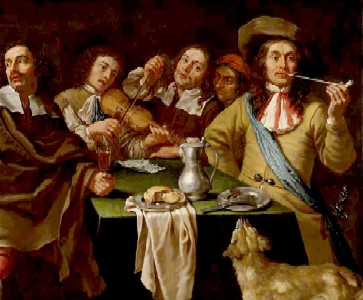
Artist: Gregorius Oosterlinck
Soliders in a Tavern. If Tryon Were There, They'd Have Killed Him (~1660)
who spent the better part of six pages of his book speaking out against this "pernicions sort of Drink in great Reputation and Use... call'd, PUNCH"7. Tryon felt that the five elements of punch were "all of as different Natures as Light is from Darkness, and all great Extreams in their kind, except only the Water."8
Tryon mentions two alcohols found in punch, (apparently not being familiar with arrack or wine punches): "Rum and Brandy are terrible hot, fierce, sulpherous Spirits, void of all the good friendly Balsamick [soothing] Vertues, and middle Quality, which is the Moderator and Qualifier in each Body... [these drinks are] of a fierce raging domineering wrathful Operation, or else of a stinking rank Nature"9. He goes on for two pages about the virtues of balsamic beverages and how rum and brandy lack them.
He warns that limes "are an immature Fruit, wherein the Martial [fiery] and Saturnine [melancholy] Poysons are so powerful that the Sun and Elements have not had power to awaken the Balsamick Vertues, or bring the Properties of Nature into an equal Operation, as it hath in other Fruits."10 However, he admits "these Extreams are some-what allay'd or moderated by the friendly Ingredients, viz. Water and Sugar, which do not only render it pleasurable to the Pallate, but also more tollerable to the Stomach."11 Unfortunately, this balance cannot save the concoction, "For the first [two ingredients] leave the Stomach...
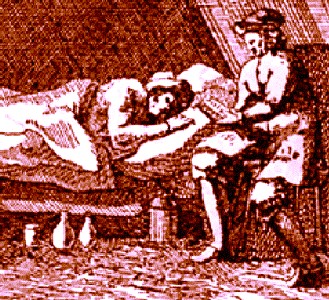
Artist: Hans Friedrich Fleming
A Man Who Probably Had Too Much Punch (1726)
either Craving and in want, or disordered. For when such improper Compositions of Mature and Immature Fruits and Unwholsom Liquors come into the Body", they are separated by the stomach, which shoots them back up, leaving a sour taste in the mouth.12
He brings the thing around to his real point (variations on which appears in several of his books about food and drinks), "There are but few that are truly sensible of the many sore Evils and Dissatisfactions improper Mixtures in Diet brings upon the Body and Mind of Man."13 Tryon closes by explaining that it is needless to inflict such things on the body, because "when all's done, the enjoyment of them gives neither Satisfaction to the one nor Health to the other, but makes our Wants the greater; for presently we shall want Doctors and Physick to repair those Ruins which our own Intemperances have made... being the original Causes of those cruel Belly-Akes and griping Pains in the Bowels, Feavers, Fluxes and Dropsical Diseases"14. He may have a point - all those symptoms mght occur from drinking too much. However, Tryon is probably one of those people you wouldn't want to invite to your parties.
1 The Way to Health and Long Life, 1726, p. 39; 2,3,4 William Salmon, Pharmacopœia Bateana or_Bate’s Dispensatory, 1694, p. 759; 5 William Bosman, A New and Accurate Description of the Coast of Guinea, 1706, p. 49; 6 Hans Sloane, A voyage to the islands of Madera, Barbados, Nieves, S. Christophers and Jamaica, Vol. 1, 1707, p. xxviiii-xxx; 7 Thomas Tryon, The Country-Man’s Companion, 1684, p. 110; 8,9 Tryon, p. 111; 10.11 Tryon, p. 112; 12 Tryon, p. 112-3; 13 Tryon, p. 113

